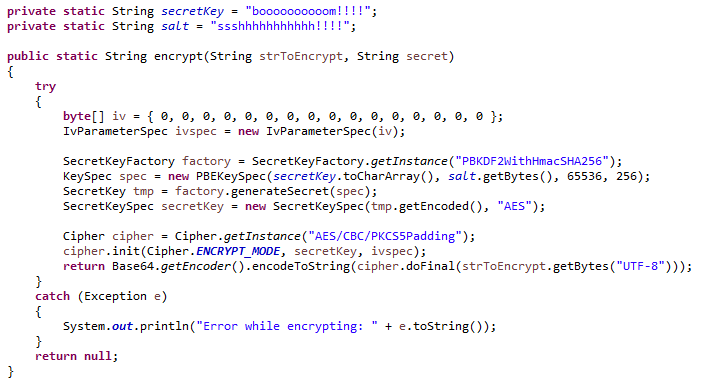Generate Aes Key From Password Java
AES-256 Encryption with Java and JCEKS. The AES key is nothing more than a. This post will not show the generation of a key using this method or the use of a PBE key method using a password. The Java KeyGenerator class (javax.crypto.KeyGenerator) is used to generate symmetric encryption keys. A symmetric encryption key is a key that is used for both encryption and decryption of data, by a symmetric encryption algorithm. In this Java KeyGenerator tutorial I will show you how to generate symmetric encryption keys.
By Lokesh Gupta Filed Under: Java SecurityLearn to use Java AES 256 bit encryption to create secure passwords, and decryption for password validation. To read simple AES encryption, read linked post.
1. AES – Advanced Encryption Standard
AES is a symmetric encryption algorithm. It was intended to be easy to implement in hardware and software, as well as in restricted environments and offer good defenses against various attack techniques.
AES is block cipher capable of handling 128 bit blocks, using keys sized at 128, 192, and 256 bits. Each cipher encrypts and decrypts data in blocks of 128 bits using cryptographic keys of 128-, 192- and 256-bits, respectively. It uses the same key for encrypting and decrypting, so the sender and the receiver must both know — and use — the same secret key.
In below encryption and decryption example, I have used base64 encoding in UTF-8 charset. It is done for displaying the output of program. If your application, you can store and validate the data in byte array format as well.
2. AES 256 Encryption
Java program to encrypt a password (or any information) using AES 256 bits.
Do not forget to use same secret key and salt in encryption and decryption.
3. AES 256 Decryption
Java program to decrypt a password (or any information) using AES 256 bits.
4. Java AES 256 Example
Let’s test our AES256 encryption and decryption methods with a simple string.
Program output.
Clearly, we are able to use AES256 encryption to encrypt a string, and decryption to get back original string from encrypted string.

Happy Learning !!
Read More:
What is AES?
If a code signer does not yet have a suitable private key for signing the code, the key must first be generated, along with a corresponding public key that can be used by the code receiver's runtime system to verify the signature.
Java Generate Aes Key From Password
Since this lesson assumes that you don't yet have such keys, you are going to create a keystore named examplestore and create an entry with a newly generated public/private key pair (with the public key in a certificate).
Type the following command in your command window to create a keystore named examplestore and to generate keys:
You will be prompted to enter passwords for the key and keystore.
Subparts of the keytool Command
Let's look at what each of the keytool subparts mean.
- The command for generating keys is -genkey.
- The -alias signFiles subpart indicates the alias to be used in the future to refer to the keystore entry containing the keys that will be generated.
- The -keystore examplestore subpart indicates the name (and optionally path) of the keystore you are creating or already using.
- The storepass value that you are promted for specifies the keystore password.
- The keypass value that you are prompted for specifies a password for the private key about to be generated. You will always need this password in order to access the keystore entry containing that key. The entry doesn't have to have its own password. When you are prompted for the key password, you are given the option of letting it be the same as the keystore password.
Note: For security reasons you should not set your key or keystore passwords on the command line, because they can be intercepted more easily that way.
Distinguished-Name Information
If you use the preceding keystore command, you will be prompted for your distinguished-name information. Following are the prompts; the bold indicates what you should type.
Command Results
Generate Aes Key From Password Java Free

The keytool command creates the keystore named examplestore (if it doesn't already exist) in the same directory in which the command is executed. The command generates a public/private key pair for the entity whose distinguished name has a common name of Susan Jones and the organizational unit of Purchasing.
The command creates a self-signed certificate that includes the public key and the distinguished-name information. (The distinguished name you supply will be used as the 'subject' field in the certificate.) This certificate will be valid for 90 days, the default validity period if you don't specify a -validity option. The certificate is associated with the private key in a keystore entry referred to by the alias signFiles.
Self-signed certificates are useful for developing and testing an application. However, users are warned that the application is signed with an untrusted certificate and asked if they want to run the application. To provide users with more confidence to run your application, use a certificate issued by a recognized certificate authority.
Java Secretkeyspec Aes
Note: The command could be shorter if option defaults are accepted or you wish to be prompted for various values. Whenever you execute a keytool command, defaults are used for unspecified options that have default values, and you are prompted for any required values. For the genkey command, options with default values include alias (whose default is mykey), validity (90 days), and keystore (the file named .keystore in your home directory). Vsphere 6.5 key generator. Required values include dname, storepass, and keypass.